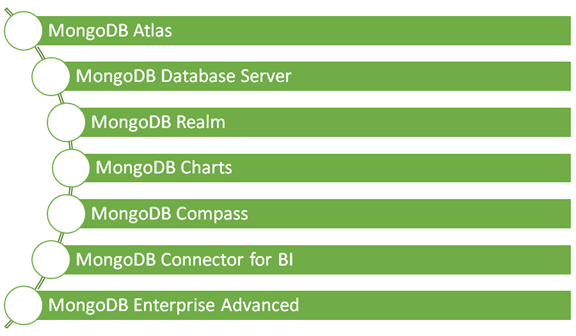Advance your modernization journey with the MongoDB
MongoDB is a popular, open-source NoSQL database that provides high-performance, scalable, and flexible data storage solutions. It uses a document-oriented data model, storing data in JSON-like documents that can be easily queried and indexed. MongoDB offers features like high availability, horizontal scalability, and automatic sharding, making it suitable for handling large amounts of data in distributed environments. Its flexible schema allows for dynamic changes in data structure, enabling agile development and faster iteration. MongoDB also supports various programming languages and provides rich querying capabilities, including advanced aggregation and indexing options. Overall, MongoDB is widely used for building modern, data-intensive applications.

MongoDB is a leading modern database platform that offers a wide range of products and services to support your modernization journey. Whether you are looking to build new applications or modernize existing ones, MongoDB provides the tools and technologies to help you succeed. Here are some key products in the MongoDB line-up that can advance your modernization efforts

The explosion of data generated by mobile applications and devices requires a data management solution that can manage these systems and securely collect and synchronize data. However, solutions based on unified architectures (such as RESTful Web Services) do not meet the usability, performance, and security needs of today’s applications.
MongoDB Realm offers a full-featured solution that enables seamless edge-to-cloud synchronization and guaranteed data availability regardless of network connectivity.
Enterprise Mobility
Enhance your enterprise mobility solutions with MongoDB Realm and Atlas Data Lake
Companies are paying more attention to mobility, either from the perspective of the employee or the organization. This requires the integration of mobility into the enterprise to serve certain business processes or to radically redefine operational paradigms.
From this perspective, organizations begin to develop viable mobility strategies. Learning the basics and researching the right mobility solutions that perfectly match your organization’s goals is one of the key factors in successfully implementing your enterprise mobility strategy.
Due to the growing mobile needs of businesses, design teams face many challenges when creating mobile apps, and without the right solution to address them, their mobile strategies will collapse.
What challenges do design teams face when building mobile apps today?
- In the unpredictable environment of mobile applications, where network connections can be interrupted, devices can shut down at any time due to excessive use of battery or system resources.
- Coordinate between multiple backend APIs and local databases to maintain a common object graph to work with.
- Building the first offline features
- Responding to data changes between backend systems and mobile interfaces introduces additional layers of code.
- Keeping application layers secure with data at rest transmitted and stored in the backend cloud.
- Consistent object serialization across networks, database storage, and application memory.
- Simplified cross-platform support on iOS and Android platforms with developer-friendly SDKs.
How can MongoDB Realm help solve your challenges?
- Cross-platform – Use one database to build all your apps – iOS/Android.
- Offline first – Designed for 100% offline use, you can create an experience as good as web applications.
- Object Oriented – Code written with Realm is lean in the sense that it can save thousands of lines of code.
- Reactive Architecture – Realm’s unique real-time objects ensure that data updated anywhere is automatically updated everywhere.
- Simplified data synchronization – Automatically synchronize data from Realm Mobile Database to MongoDB Atlas. The synchronization protocol resolves conflicts consistently across each workstation and linked MongoDB Atlas cluster.
- Efficiency – Fast consultation thanks to zero-copy architecture and internal MVCC architecture and secure chaining – reading and writing can happen simultaneously without slowing down your experience.
- Optimized for mobile use – speed, battery life and data transfer are effectively used to create a fast and optimal mobile experience.
- Secure – Fully protect your data in flight or at rest with transparent encryption and decryption.
Internet of Things
Enhance your Internet of Things (IoT) with MongoDB Realm and Atlas Data Lake
Today, the Internet of Things allows companies to connect the physical and digital worlds. Understanding the business value of connecting all these “things” enables the creation of new revenue models, increases productivity, and generates new insights that increase operational efficiency.
What challenges do design teams face when creating IoT Applications?
- Volume and speed – the ability to process data from very large volume and rapidly arriving data sources from the edge to the cloud.
- Real-time processing – IoT data is massive and arrives at high operational speeds. IoT solutions that require data to be moved (through ETL or similar processes) to another reporting or analytics system consume critical time and resources that may not be needed, creating a more complex overall architecture.
- Schema rigidity – SQL, the language used to query relational databases, is not well suited for working with time series data. Requiring a fixed formula does not allow for the flexibility and agility needed for today’s systems. For example, adding a new sensor type to an existing application may require changing the array diagram, leading to application downtime or complex multi-resource coordination.
- Inflexible data models – The ability to accommodate new data models and the fact that there is a lot of unstructured data leads to a lot of repetitive design work.
- Inability to scale as data and processing needs evolve.
How can MongoDB Realm and MongoDB Atlas help solve your challenges?
- The offline-first access model works very well to fully lock data and synchronize when needed, even with low network bandwidth.
- Simplified data synchronization – Automatically synchronize data from Realm Mobile Database with MongoDB Atlas without worrying about conflicts or data consistency.
- Well suited for data entry for frequent or irregular stroke writing.
- Support for flexible and dynamic data models that allow consuming different data formats from sensors.
- A small footprint that can run on suitable end devices or even a Raspberry Pi in an IoT network.
- Enables transformation and processing of data in the OT network at the edge device.
- The central data layer produced by Atlas MongoDB can store data and process IoT data of any structure: events, time series data, geospatial coordinates, text and binary data such as images from connected devices.
- Atlas MongoDB multi-cloud support Built for optimal performance with on-demand scaling, resource optimization tools and real-time insight into database performance.Fully automated infrastructure management, database installation, maintenance and updates.
- Enhanced security features to meet new and existing data protection and compliance measures.
- Support for instantiated services such as GraphQL APIs, functions and triggers that accelerate development.
Data Ecosystem
Powering your Data Ecosystem MongoDB Atlas Data Lake
With the advent of big data technologies, many companies are adopting new information storage models called data lakes to solve their data management challenges. The data lake model is adopted as a single data layer for relational and non-relational data generated from cloud native apps, mobile apps and IoT devices for various use cases such as business intelligence, analytics, and regulatory compliance.
This helps you identify and seize opportunities for business growth faster by attracting and retaining customers, improving productivity, proactively maintaining equipment, and making informed decisions. increase.
What challenges do engineering teams face today in building out data ecosystems?
- Move Data – Import any amount of data that can be received in real time
- Existing data warehouses are optimized for analysing relational data from transactional systems and line-of-business applications, and cannot handle non-relational, unstructured data from sources such as mobile applications and IoT devices.
- Fragmented data silos make it difficult to gain insights through machine learning and predictive analytics.
- Given the prevalence of fragmentation, computational and storage costs continue to rise.
- Ability to back up and catalogue all data.
How can MongoDB help solve Atlas and Atlas Data Lake challenges?
- The central data layer produced by Atlas MongoDB and Atlas Data Lake can store data and process related and non-related data of any structure: events, time series data, geospatial coordinates, text, and binary data such as images from connected devices.
- Flatten your data into fully managed databases and cloud object storage with Atlas Online Archive, which supports real-time and historical data access.
- Reducing computing and storage costs using Atlas Data Lake and online archiving.
- Analyse rich data easily and intuitively using powerful and easy-to-understand joins with MQL to ensure a consistent user experience across all data types.
- Work with data at any scale because Atlas Data Lake is serverless without worrying about capacity projections
- Atlas MongoDB multi-cloud support
- Built for optimal performance with on-demand scaling, resource optimization tools and real-time insight into database performance. Fully automated infrastructure management, database installation, maintenance, and updates.
- Enhanced security features to meet new and existing data protection and compliance measures.
